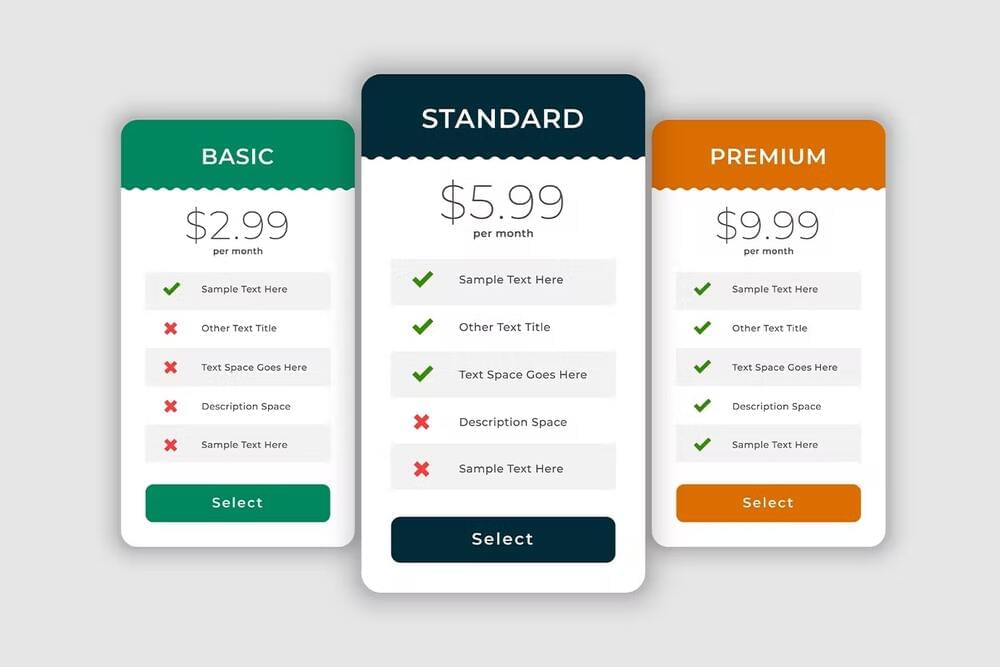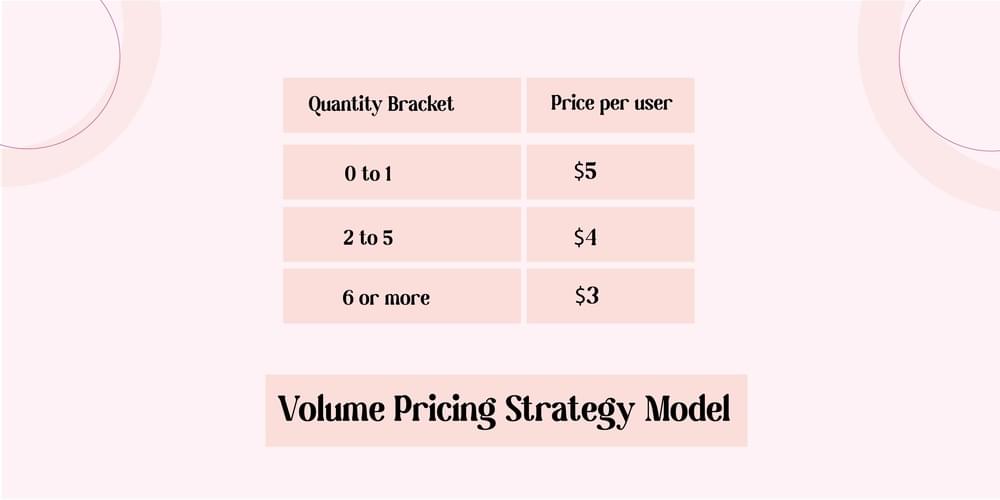
Tiered & Volume Pricing Strategy, Models, & Examples

The best pricing strategy model helps businesses make the right decisions when pricing their products or services. They can use it to determine the optimal price point for their products or services and ensure that maximized profits.
Improper price structure or unfair division of prices can force your users to pick your competitors’ products/services with a better pricing strategy. When it comes to retaining your customers choosing the best pricing model for your business is the first most step to take.
What pricing strategy model you should choose for your business? The read of this blog will give you deeper insight into tiered and volume pricing strategies for you to take pick the best suited structure to your business.
Tiered pricing vs. Volume pricing
Regarding pricing strategies, there are two main options: tiered pricing and volume pricing. Both have pros and cons, so it’s important to understand their differences before deciding which one to use for your business.
Tiered pricing is a SaaS or subscription-based pricing model that invites customers to choose their desired subscription plan. Each tiered pricing plan or package costs are incremental and set by features and usage limit. It means customers’ desires are put in separate plans, and they choose accordingly. They can choose their plans on either a monthly or annual basis. They can receive discounts on annual plans mostly.
Regarding flexibility of choice, a tiered pricing strategy is a win-win for both companies and customers. It is more leverage for businesses as they can invoke consumers’ appeal and let them have complete freedom to make the right choice for themselves. On the other hand, users don’t feel pressure in a one-size-fits-all plan. Below is an example of how the tiered pricing strategy is devised.

Tiered pricing is a pricing strategy that involves offering different prices for different levels of products or services. The idea is that customers will pay more for higher levels of service or products. For example, a company might offer basic, standard, and premium tiers with different prices for each level. Tiered pricing can encourage customers to purchase higher-level products or services, as they will get more value from them.
Below is an example from Churnfree:

On the other hand, a volume pricing strategy is a pricing strategy that involves offering discounts for larger orders. This strategy is often used by wholesalers and retailers who want to encourage customers to purchase in bulk. Volume discounts can be used to reward loyal customers or attract new ones. It’s also a great way to increase sales and profits since customers will likely buy more when they get a discount.
So which one should you choose? It depends on your business and your goals. A tiered pricing strategy can be effective if you have different levels of products or services that customers may be willing to pay more for. A volume pricing strategy can be great if you want to increase sales and profits by encouraging customers to buy in bulk.
Below is an example from shutterstock:

A-pro trip: both tiered pricing and volume pricing can be used together. For example, you could offer tiered prices for different levels of products or services while also offering discounts for larger orders. This way, you can maximize profits while still providing customers with the best value possible.
Ultimately, it’s important to consider a tiered & volume pricing when creating your pricing strategy. Both have their benefits and drawbacks, so it’s essential to weigh the pros and cons of each before deciding which one is right for your business. With the right strategy, you can maximize profits while still providing customers with the best value possible.
Five pros of the tiered pricing strategy that will help you decide on better pricing strategy models for your business
The tiered pricing model is the pricing structure that allows companies to offer different levels of service at different prices, allowing customers to choose the option that best fits their needs and budget. The tiered pricing model can be a great way to maximize profits while still providing value to customers.
Overall, the tiered pricing strategy is a great way to maximize profits while still providing value to customers. It offers increased revenue potential, improved customer satisfaction, increased upsell opportunities, a more accessible pricing structure, and greater flexibility in setting prices.
#1. Sometimes, more freedom of choice means more Increased Revenue!
For SaaS-based businesses, it is important for them to keep a keen eye on revenue on monthly or yearly basis. Therefore, devise a price plan that gives them flexibility and freedom of choice.
The users like it when they are presented with flexibility and freedom of choice. The tiered pricing strategy can become their convenience, having more options to choose from, leading to increased revenue for your business. By offering different levels of service at different prices, you’re allowing customers to choose the option that best fits their needs and budget—leading to more sales and higher profits for your business.
#2. More often, freedom of choice also means more Improved Customer Satisfaction!
For subscription-based businesses, keeping your customers happy is important. Keeping them happy also means making them realize that your products/services continue to add value into their lives and you offer flexible pricing policy for all products/services.
By offering different levels of service at different prices, you’re allowing customers to choose the option that best fits their needs and budget—leading to improved customer satisfaction, as customers feel like they’re getting a good deal. They don’t feel forced into buying a service they don’t need or can’t afford.
#3. Seeing the real value of your products Upselling becomes easy!
Who doesn’t like new features with incredible functionalities? continuing to adding new features or offering continuous discounts can help you reduce customer churn.
With a tiered pricing strategy, you can offer higher-priced options with additional features or services that may be attractive to some customers—allowing you to upsell customers on higher-priced options and increase your profits.
#4. Easily understood Pricing Structure
Simplicity is the key!
Tiered pricing models make it easier for customers to understand your pricing strategy models and decide which option is best for them. With a simple tiered structure, it’s easy for customers to compare the different options and decide which one is right for them.
#5. Flexibility is always admired in so non-flexible economy
Tiered pricing strategies provide flexibility when setting prices, as you can easily adjust the price of each tier depending on market conditions or customer demand—helping you ensure that you’re always offering competitive prices and maximizing your profits.
Tiered pricing examples
Regarding pricing strategy models, tiered pricing is one of the most popular and effective methods. This approach allows businesses to set different prices for different customers or customer segments based on the value they offer. Tiered pricing is a great way to maximize profits while offering customers the best possible deal.
At its core, tiered-based pricing is a way to differentiate customers based on their willingness to pay. It’s a great way to reward loyal customers and incentivize new ones. Plus, it’s easy for businesses to increase their revenue without raising prices across the board.
But how do you implement a tiered pricing strategy? To help you get started, we’ve compiled five-tiered pricing strategy examples that you can use in your business.
1. Offering quantity discounts helped businesses achieve desirable results:
Quantity discounts are an effective way to reward customers for buying in bulk. For example, if customers buy ten items, they may get a discount of 10% off the total purchase price. This strategy works well for businesses selling bulk products, such as wholesale distributors or online retailers.
2. Loyalty Programs are always a success for any pricing model:
Loyalty programs are good to retain customers for longer period. It is also one of the famous tiered pricing strategy examples. With loyalty programs, businesses can offer discounts or other incentives to customers who make repeat purchases or stay with them for a certain time. This encourages customers to keep returning and helps build customer loyalty.
3. Tiered-based Pricing on Customer Segments:
Businesses can also use tiered-based pricing on customer segments, such as businesses or consumers. For example, businesses may offer lower prices to business customers than they do to individual consumers. This approach allows businesses to target different customer segments and maximize their profits from each segment.
4. Variable Pricing Based on Demand:
Variable pricing is another tiered pricing strategy considering demand levels for certain products or services. With variable pricing, businesses can adjust their prices based on demand levels to maximize profits and offer customers the best deal possible.
5. Bundling Products:
Bundling products is an excellent way for businesses to increase revenue while offering customers the best deal possible. By bundling products, businesses can offer discounts or other incentives that make it more attractive for customers to buy multiple items at once rather than individually.
Cons of tiered pricing strategy if it’s poorly structured
Businesses should carefully weigh the pros and cons of tiered pricing before deciding if it is right for them. For millions, a tiered pricing strategy works best, but it can result in poor pricing strategy if it needs to be planned better. These include complexity, alienation, price discrimination, lower profits, and lack of flexibility.
1. It can grow complex for some users
One of the most significant disadvantages of tiered pricing is its complexity. Tiered pricing strategy requires businesses to set different prices for different customer segments, which can be challenging to manage. This complexity can lead to confusion among customers and make it difficult for them to understand the different pricing tiers and how they affect their purchase decisions.
2. Some users can feel alienation
Another disadvantage of a tiered pricing strategy is that it can alienate specific customer segments. For example, suppose a business sets higher prices for specific customer segments, such as those with higher incomes. In that case, it could lead to feelings of alienation among those customers–leading to lower sales and decreased loyalty among those customers.
3. Some users feel price discrimination.
The higher prices is one the big time mistakes lead to more churned customers. Tiered pricing, if designed improperly, can also lead to price discrimination when a business charges different prices to customers based on factors such as income level or location. This pricing strategy can be seen as unfair and unethical, as it discriminates against specific customer segments and could lead to legal issues for the business.
4. Poor pricing strategy can bring lower profits
Poor pricing means more users are deciding to churn. if you are not careful with the pricing, tiered pricing can result in lower profits. If a business sets fewer tiers or charges less for its higher-priced tiers, customers may prefer to purchase from the business. This could result in lower overall sales and profits for the business.
5. You can face inflexibility if a tiered pricing strategy is not well-structured
Finally, a tiered pricing strategy can be inflexible and difficult to adjust if a business needs to adjust its prices or add new tiers in response to changing market conditions or customer demands. This lack of flexibility can make it difficult for businesses to remain competitive and respond quickly to changes in the market.
Five pros of volume pricing strategy for a greater understanding of the pricing model for your business
The business world is constantly evolving, and so are the strategies used to maximize profits. One such strategy is volume pricing, which can be an incredibly effective tool for businesses of all sizes. Volume pricing strategy is where customers are offered discounts based on the number of goods or services they purchase. This strategy encourages customers to buy more, resulting in increased sales and profits for the business.
Volume pricing strategy is an effective pricing model to help businesses maximize profits and improve customer relationships. By offering discounts based on the quantity purchased, businesses can encourage customers to buy more, leading to increased sales volume and improved profits. Additionally, this pricing strategy helps create loyal customers more likely to return in the future, further boosting profits for your business.
Volume pricing strategy model and how its discounts work:

1: Your customers become more loyal to you
One of the most significant benefits of a volume pricing strategy is that it can help to increase customer loyalty. When customers are offered discounts based on the amount they purchase, they’re more likely to return and buy again. This repeat business helps to build customer loyalty and trust in your brand, creating a solid foundation for future success.
2: You end up increasing Sales Volume
Volume pricing models also encourage customers to buy more than they usually would. Customers may be enticed by the discounts offered and purchase more than they originally intended—increasing sales volume and helping to boost profits for your business.
3. Inventory management becomes easier
When customers buy in bulk, it makes it easier for businesses to manage their inventory. With more predictable sales patterns, businesses can better plan their inventory needs and avoid overstocking their products—helping to reduce costs associated with managing inventory and can help improve overall efficiency.
4. Volume pricing strategy can prove to be more profitable
The increased sales volume from volume pricing can also increase your business’s profits. Offering discounts based on the amount purchased encourages customers to buy more than they normally would, leading to increased revenue for your business.
5. Volume pricing strategy turns out to be improving Customer Relationships
Volume pricing models can also improve customer relationships by showing that you value their business and appreciate their loyalty. Offering discounts based on the amount purchased shows customers that you’re willing to reward them for their loyalty, which can help strengthen your relationship with them over time.
Five disadvantages of volume pricing strategy if implemented improperly
Volume pricing strategy is an effective strategy that can help increase sales and boost business profits when used correctly. However, there are potential drawbacks that businesses should consider before implementing this strategy, including limited customer base, price points, unpredictable demand, unprofitable sales, and competitor response.
1. Limited Customer Base: Volume pricing strategy requires customers to purchase a certain amount of products or services to qualify for the discount. Only customers who need many products or services can take advantage of the discounted prices. It can limit your customer base and make it difficult for small businesses or those just starting to benefit from the discounted prices.
2. Price Points: Price points that are too high for some customers can lead to lost sales. It’s essential to consider the price points you set and ensure they are within reach for your target audience.
3. Unpredictable Demand: If demand is unpredictable, you may not be able to offer discounts on certain items when needed. It can lead to lost sales and decreased profits.
4. Unprofitable Sales: Volume pricing strategy can benefit businesses if used correctly, but it can also lead to unprofitable sales if not appropriately managed. If customers take advantage of the discounts and purchase more than they need, businesses may be unable to recoup their costs and may lose money on the sale.
5. Competitor Response: Businesses should consider how their competitors will respond when implementing volume pricing strategies. If competitors offer similar discounts, businesses may need help competing on price and lose out on potential sales and profits.
Bottom-line:
With the growing competition everyday, keeping a keen eye on customer retention rate is important. You cant ignore the metrics of how many customers decide to leave your services on monthly or annual basis. Your business cannot rely on haunch basis methods anymore. Therefore, most SaaS-based or subscription based business use tools like Churnfree to know the reasons of why their customers decide to churn. This tool can feed you with deep insights of why your customers are leaving you. Relying on the valuable information provided by Churnfree you can devise an effective user retention strategy.

